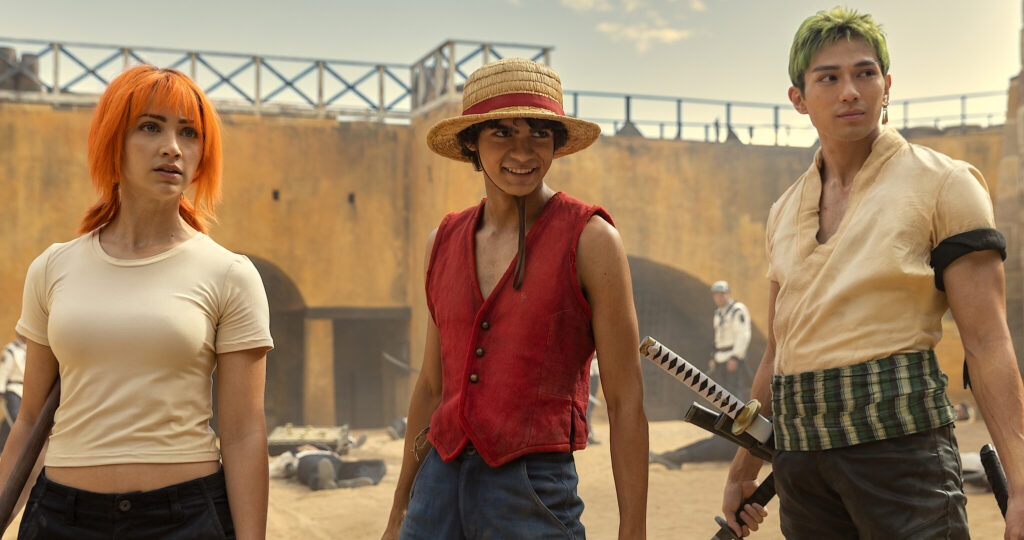For those fans who have watched over a thousand episodes and have stuck with One Piece all along the way, the famous walk to Arlong Park was one of the most significant points of the whole story. Like all those memes, One Piece did suddenly get better from episode 37 (I loved it from the beginning, but I also couldn’t help but notice the shift in nature of the show, and its transformation into an anime full of iconic arcs). The circumstances leading up to the fearless and decisive steps towards the hideout of a monster – who was, for all intents and purposes, stronger beyond hope were perfect to encapsulate the essence of One Piece. It showed Nami at her strongest and her most helpless, Luffy at his most stubborn nature. Nami pushing Luffy away time and time again, Luffy refusing to step in unless Nami acknowledged she needed his help, and when she finally asks for help – Luffy pushing down the iconic straw hat that he held so dear to his heart all his life onto Nami’s head – it just couldn’t get better.
This is why one of the most important factors for me in deciding whether One Piece Live Action managed to deliver an unprecedentedly successful adaptation of an anime was whether it managed to execute the walk to Arlong Park successfully. If OP Live Action did manage it, I would’ve overlooked a lot of the other flaws the adaptation possessed.
Unfortunately, the adaptation disappointed in most of the areas in such an iconic part of the story, as it did for most of the other places as well. The Luffy here resembles a protagonist from an average superhero film with corny lines, the Nami here doesn’t come close to showing the desperation she experienced in the origin story. Of course, an adaptation doesn’t stick quite stringently to the origin story. Changes should be welcome, but only when they make the story better.

Unfortunately, Netflix’s adaptation felt like it tried too hard to copy the all too familiar template of a team of individuals assembling and fighting evil with cheesy lines and weak attempts at humor – which might sell easy. It felt flat, uninspired, and dull – which is a real shame because the adaptation did an incredible job of creating brilliant special effects that made the action sequences feel so real.
Characters Failing to Capture the Essence of the Origin Story
Even though One Piece is a long-running anime, one of the key aspects that made the show successful was its lively, vibrant, and unique characters. The main crew, for example, are in no way perfect human beings. But what are they definitely not? Templates. And this is where I’ve felt Netflix’s adaptation didn’t meet the expectations.
We can take Luffy, for example. I would give credit to Iñaki Godoy, who did try his best to provide an energetic performance.
However, it was unfortunate to see Luffy not showing his unique mixture of stupidity, stubbornness, and a total lack of disregard for what others might be thinking. What we do end up seeing is a person who is quite compassionate, isn’t nearly as blunt as the anime character, surprisingly able to read others’ emotions, and definitely nowhere near as dumb (in general) as the origin Luffy.
The same goes for almost all the characters. The Netflix adaptation went on its own way of rebuilding the characters’ essences, which I am not really against the conception of. However, I was disappointed to see the characterization ultimately succumbing to mere templates of characters that might be found in almost any comedy-action drama. The adaptation didn’t do justice to the extremely unique nature of the characters we experienced in the anime.
The Humor Falling Quite Flat Compared to the Anime
As an anime, One Piece depends greatly on energetic and chaotic humor, emotional solid arcs, and extended fight scenes. From Luffy’s most random comments and actions to Zorro getting lost everywhere (which, of course, has given birth to countless memes where Zorro ultimately ends up in other animes), Usopp’s exaggerated stories and ludicrously selfish acts in front of strong opposition’s.
However, the comedic element in the live-action adaptation felt dull. It felt pretty try-hard at times. The chaos wasn’t there, nor was the energy. The live-action’s humor did not live up to the levels of the anime at all. As an avid One Piece lover, I was disappointed with the end product.
The Aspects that Clicked: Special Effects Exceeded Expectations
Undoubtedly, it is surely the best part, albeit not flawless. One Piece was always going to be a massive challenge to be turned into a live-action. The characters look so weird (especially the villains), and the powers of the characters as well as the fights, are so incredulous that I didn’t expect them to be adequately represented in a live-action.
However, the OP Live Action does a fantastic job of getting the special effects right. Of course, there were some shortcomings, too (Arlong’s look and size were a bit disappointing, and so were most of Luffy’s fights). However, the live-action managed to pull off an exceptional job. I even thought that some of the show’s villains were scarier thanin the anime (Buggy’s name springs up automatically).
Credit where it’s due. Thelive-action was brilliant in its execution of the animation and special effects.
Final Thoughts: Progress for Live-Actions, but Disappointing Overall
One Piece’s live-action adaptation surely deserves credit for its exceptional special effects. However, that’s where it ends for a One Piece fan. There were many things that could have been improved in the adaptation. Of course, as far as live actions go, this one fared quite a bit better than most other adaptations anime fans have endured (Dragonball Evolution and Cowboy Bebop are painful reminders). So, progress? Yes.
But a success? Financially, yes. But in terms of execution, in my eyes, nope.